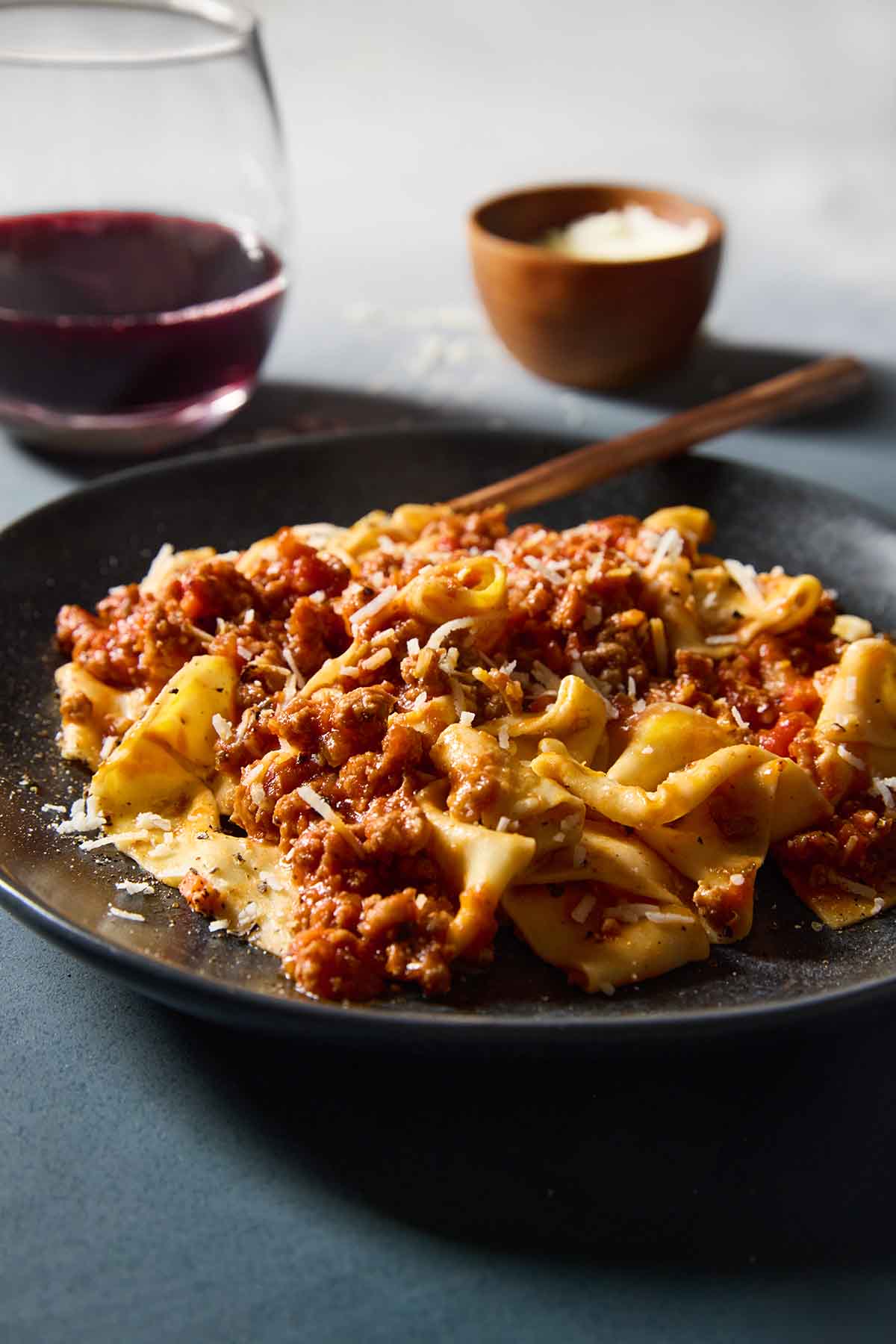
In her first cookbook, The Classic Italian Cookbook, Marcella Hazan offers the home cook an authentic Bolognese sauce recipe. The recipe calls for chuck and/or beef necks—the traditional kind an Italian grandmother would approve of, thank you very much.
This is my version of her recipe, with some tweaks. I’ve added veal and pork to the beef, which add a richer, more complex flavor. And I’ve doubled her recipe because we never had any leftovers to freeze!
Yes, it does take a while to make, although most of the time, the Bolognese gently simmers unattended on the back burner, except for occasionally making lazy eights with a wooden spoon.
Chow,


Why This Recipe Works
This Bolognese works because it respects the science and the tradition. Simmering the meat in milk isn’t just old-school—it enhances tenderness by gently breaking down proteins. The calcium and mild lactic acid in milk help activate the meat’s natural enzymes, softening the texture without making it mushy. The milk’s fat and proteins also add moisture and richness, giving the sauce its signature velvety mouthfeel.
The San Marzano tomatoes cook down during the long cooking, lending balanced sweetness and acidity. That last knob of butter enriches and emulsifies the sauce. About the only concentration not going on here is yours this is pretty much a set-it-and-forget-it sauce.
Notes on Ingredients
- Ground chuck—You can use all beef or a combination of veal and beef. The fat renders slowly during the long simmer, adding richness and preventing the meat from drying out. According to Hazan, the most desirable cut of meat is the neck portion of the chuck. You may have to put a special order for it from your butcher.
- Milk—The enzymes in milk help to soften the proteins in the meat to make it more tender. Don’t be tempted to use low-fat milk; the added fat in whole milk adds a welcome layer of richness to the sauce.
- San Marzano tomatoes—Their lower acidity and dense flesh make them ideal for long-simmering sauces like Bolognese, breaking down beautifully without adding excess water. I prefer whole tomatoes that I squeeze into the pot. It adds texture.
- White wine—Stick with a dry white here, such as Sauvignon Blanc or Pinot Grigio. Avoid sweet wines, as they’ll change the flavor of the sauce.
- Parmesan cheese—Use the imported stuff (Parmigiano-Reggiano). It makes a world of difference.
How to Make Bolognese Sauce
- Heat the oil and 6 tablespoons of the butter in a large, heavy-bottom Dutch oven until the butter is melted and stops foaming.
- Add the onion and sauté until softened.
- Stir in the celery and carrot and cook for 2 minutes.
- Add the meat and season with salt. Cook, stirring occasionally, until the meat is no longer raw.
- Pour in the milk and simmer over low heat until evaporated.
- Add the nutmeg and wine and continue to simmer until the wine has evaporated.
- Stir in the crushed tomatoes and simmer gently, stirring occasionally, until the fat separates from the sauce.
- Season to taste and serve with cooked drained pasta and freshly grated Parmigiano-Reggiano.
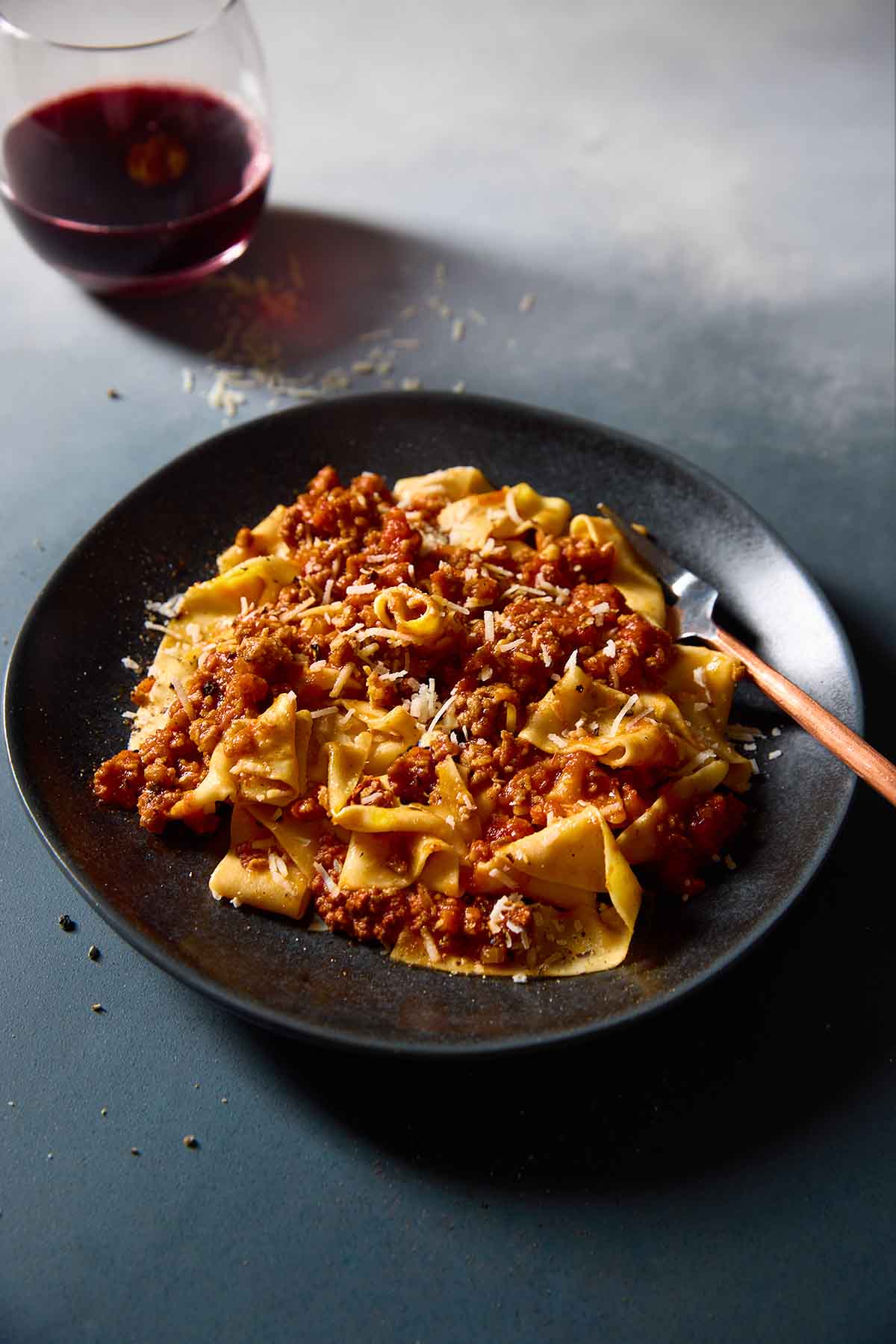
Common Questions
In essence, Bolognese sauce is spaghetti sauce. Though it’s no ordinary meat sauce. It’s a long, slowly simmered sauce that’s richer and creamier than your everyday marinara due to the inclusion of milk. It also is less predominated by tomatoes than your typical marinara. It’s named for its city of origin, Bologna.
Believe it or not, traditional Bolognese contains none of the aromatic herbs or spices that many consider necessary in all Italian dishes. You may be tempted to add them, but do your best to resist. The nutmeg is a must—don’t leave that out.
Great question! Cooking ground beef in milk is a traditional step in classic Bolognese—and there’s solid science behind it. Milk gently tenderizes the meat thanks to its calcium and mild acidity. As Harold McGee explains in On Food and Cooking, calcium can activate natural enzymes in meat that help break down proteins, softening the texture over time without making it mushy.
The milk’s fat and proteins also add moisture and richness, giving the sauce its signature velvety feel. Some cooks, including Marcella Hazan, believed that adding milk before wine and tomatoes helped “protect” the meat from acid. While that theory isn’t fully proven, the result is always the same: a rich, balanced, luxuriously tender ragù
Pro Tips
- Avoid lean cuts of beef at all costs. The more marbled it is, the sweeter the ragù will be. If you can get it, Marcella’s prized cut for this is the neck portion of the chuck.
- It’s important to season the meat with a large pinch of salt as soon as it hits the pan. This draws out the juices and imparts flavor to the Bolognese.
- Cook the meat in milk before adding the wine and tomatoes to protect it from the acidic bite of the latter.
- Use a heavy pot that will retain heat. I use my Le Creuset 5-quart Dutch oven. Avoid using cast iron, as the acid can interact with the metal and turn the sauce a blech color.
- Cook, uncovered, at the merest simmer for a long, long time. Because this is a double batch, no less than 6 hours is necessary.
What Pasta to Serve with Bolognese Sauce
Marcella recommends serving her Bolognese sauce with tagliatelle, but if you prefer spaghetti Bolognese, you can do that or even layer the sauce between sheets of pasta to create a lasagne Bolognese. Round out your meal with an easy Italian salad and a loaf of crusty bread.
Storage & Reheating
Let your sauce cool completely before storing it in an airtight container in the refrigerator for up to 4 days. Bolognese sauce can be frozen in zip-top bags or freezer-safe containers for up to 3 months. Thaw it in the refrigerator overnight before using.
To reheat your sauce, place it in a large saucepan over low heat and warm gently, stirring occasionally.
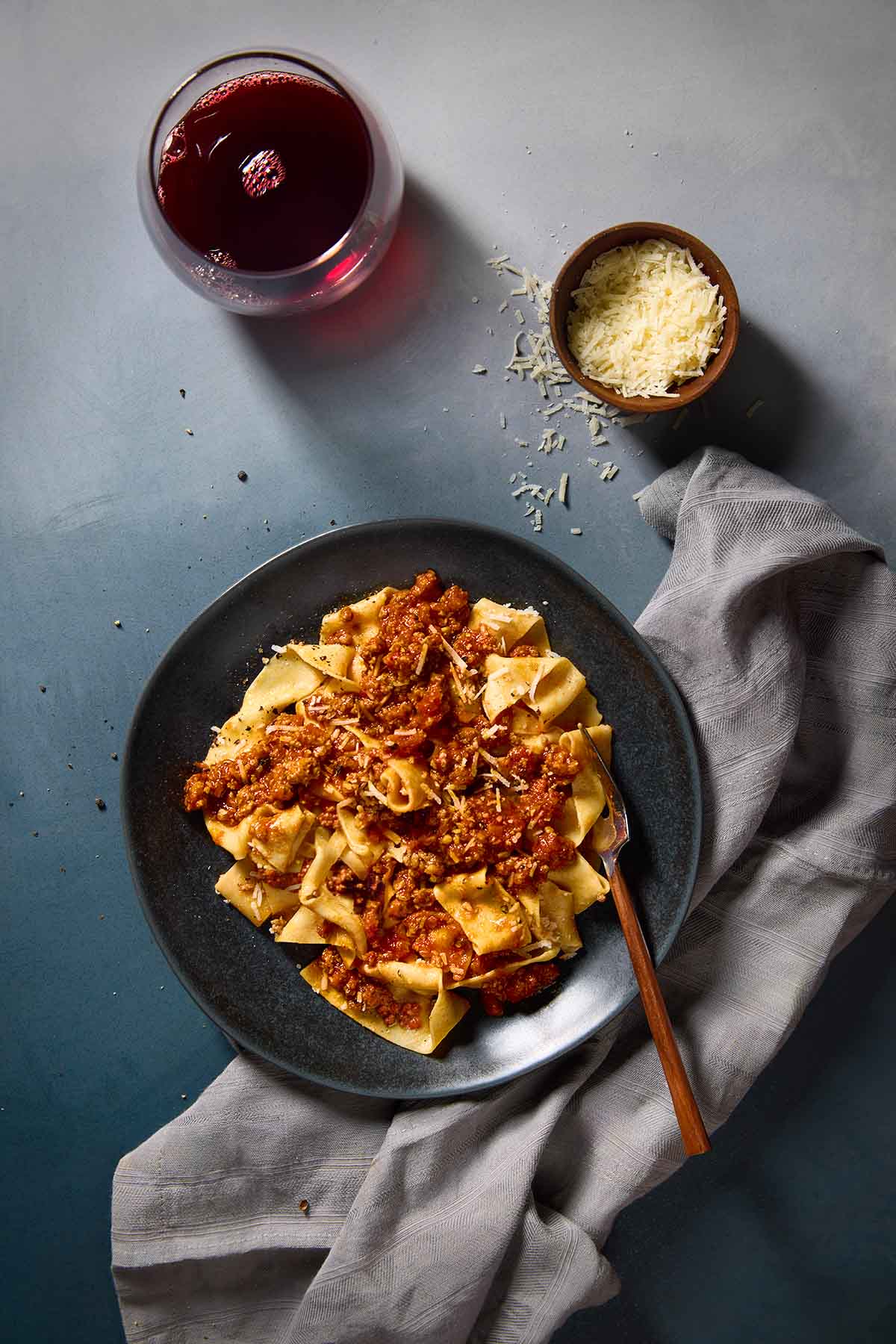
More Spectacular Pasta Sauce Recipes
Craving more pasta night magic? Try our bold and spicy marinara sauce, perfect for everything from spaghetti to meatball subs. Got a favorite meatloaf recipe? Transform leftovers into gold with this wildly clever leftover meatloaf pasta sauce—yep, really. And don’t miss this simple roasted tomato sauce, which brings deep, caramelized flavor to every bite.
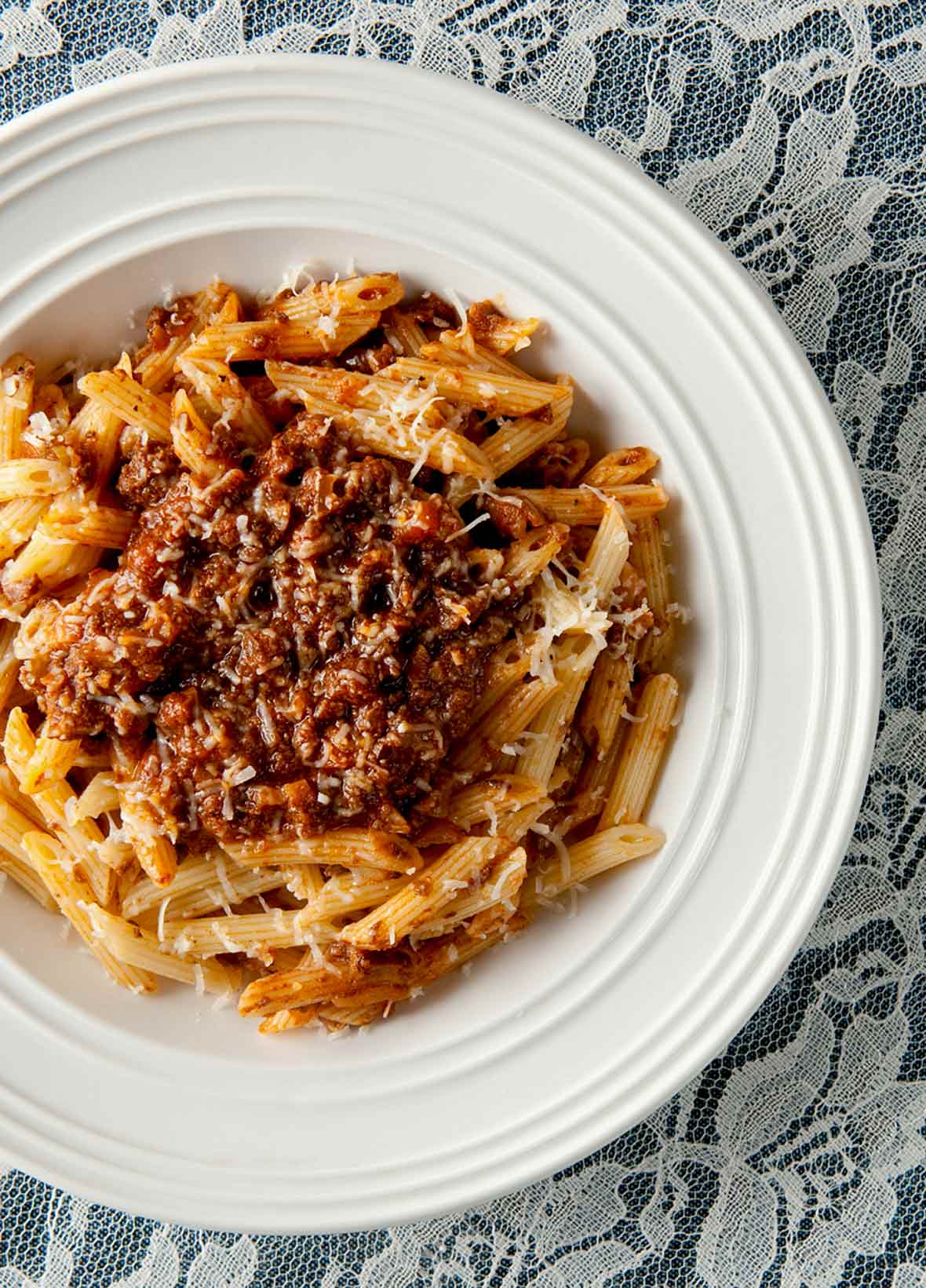
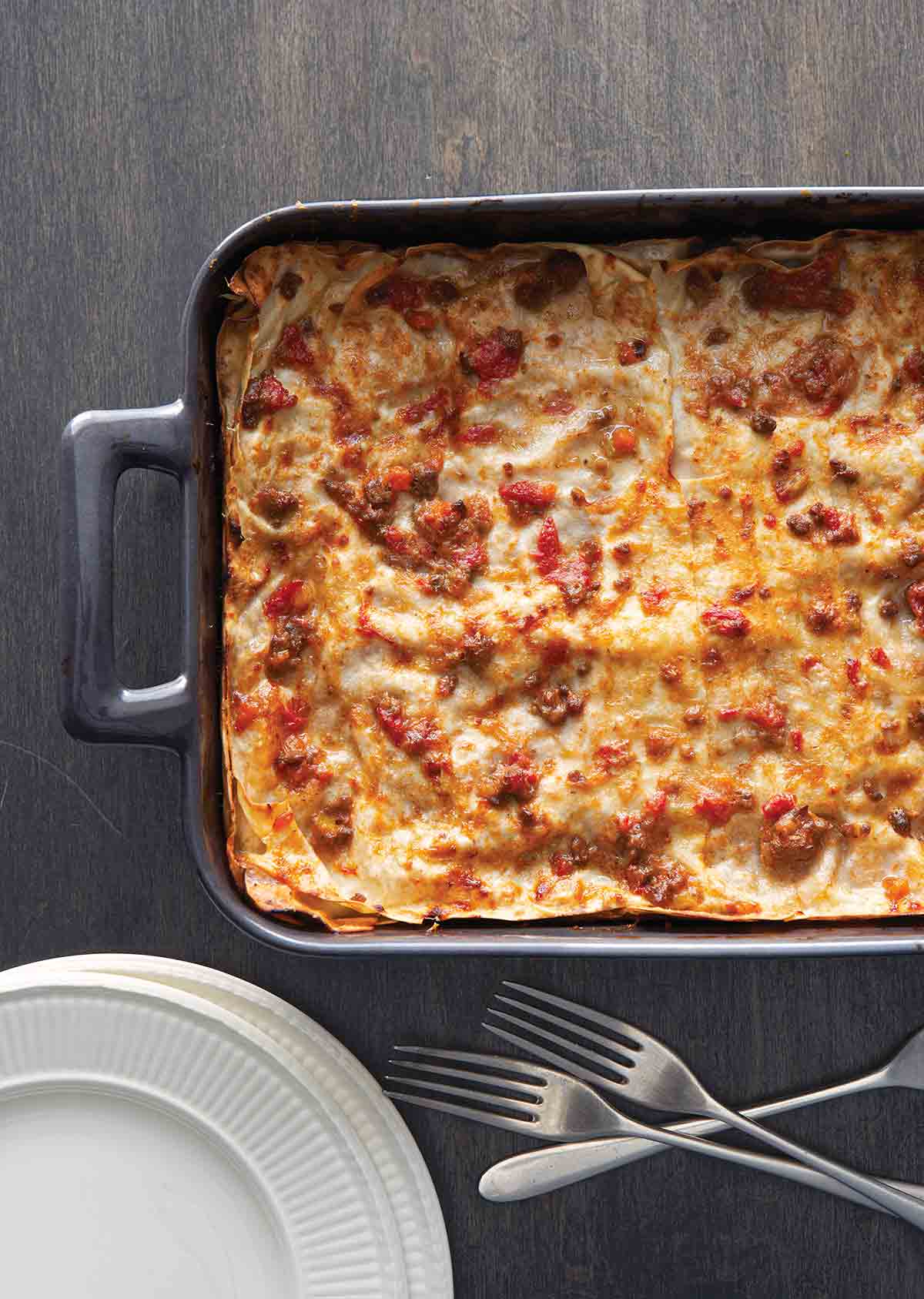
Write a Review
If you make this recipe, or any dish on LC, consider leaving a review, a star rating, and your best photo in the comments below. I love hearing from you.–David
I’ve been using recipes on Leite’s Culinaria for years and the bolognese recipe inspired by Marcella Hazan is among my favorites. Thank you, David, and team for all you do!
Jeff McWilliam
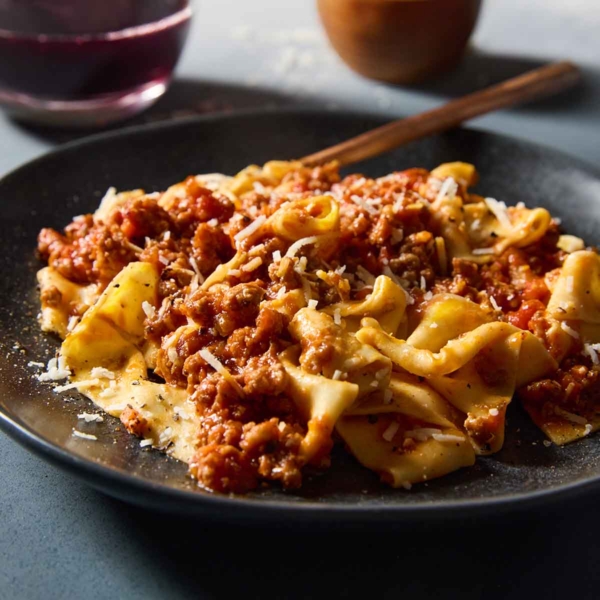
Marcella Hazan’s Bolognese Sauce
Ingredients
- 2 tablespoons vegetable oil
- 8 tablespoons (4 oz) unsalted butter, divided
- 1 cup chopped onion
- 1 1/3 cups chopped celery
- 1 1/3 cups chopped carrot
- 1 pound ground chuck, (I used 1/2 pound chuck and 1/2 pound veal)
- 1/2 pound ground pork
- kosher salt and freshly ground black pepper
- 2 cups whole milk
- 1/8 teaspoon freshly grated nutmeg, or a pinch of ground nutmeg
- 2 cups dry white wine
- 3 cups canned imported San Marzano tomatoes, (Italian plum tomatoes) with their juice
- 1 pound tagliatelle, (homemade or storebought), cooked and drained
- freshly grated Parmigiano-Reggiano cheese, at the table
Instructions
- Warm the 2 tablespoons vegetable oil and 6 tablespoons of the butter in a heavy 5-quart Dutch oven over medium heat until the butter melts and stops foaming. Toss in the 1 cup chopped onion and cook, stirring frequently, until the onion is softened and translucent, about 5 minutes.
- Toss in the 1 1/3 cups chopped celery and 1 1/3 cups chopped carrot and cook, stirring to coat them with the oil and butter, for 2 minutes.
☞ TESTER TIP: Make sure the soffritto (the onions, carrots, and celery) doesn't brown. That way, you get sweetness and depth without introducing bitter notes.
- Add the 1 pound ground chuck (and veal if using) and 1/2 pound ground pork, a very healthy pinch of kosher salt and freshly ground black pepper. Crumble the meat with a wooden spoon and cook, stirring occasionally, until the meats have just lost their raw-red color.
☞ TESTER TIP: If there's a lot of fat in the bottom of the pan due to the pork, you can spoon some out before adding the milk.
- Reduce the heat to low. Pour in the 2 cups whole milk and simmer gently, stirring frequently, until the liquid has completely evaporated, leaving just a coating of fat in the bottom of the pan, about 1 hour.
- Stir in the 1/8 teaspoon freshly grated nutmeg. Pour in the 2 cups dry white wine and gently simmer, stirring frequently, until it's evaporated, about 1 1/4 hours more.
- Add the 3 cups canned imported San Marzano tomatoes and stir well. When the sauce begins to bubble, turn down the heat so that the sauce cooks at the laziest of simmers, with bubbles breaking the surface every few seconds.
- Cook, uncovered, for 3 hours or more, stirring from time to time. While the sauce is burbling away, there's a chance that it'll start drying out. To keep the sauce from sticking to the bottom of the pot and scorching, add 1/2 cup water if necessary, just know that it's crucial that by the time the sauce has finished simmering, the water should be completely evaporated, and the fat should separate from the sauce.
- Taste a spoonful—or two—of sauce and season with salt and some good grindings of pepper to taste.
- Add the remaining 2 tablespoons butter to the cooked, hot pasta and toss with the sauce. Serve with freshly grated Parmigiano-Reggiano cheese on the side.
Notes
What You Need To Know About Making The Most Classic Italian Bolognese
- The more marbled the meat, the sweeter the ragu. (The most desirable cut of meat is the neck portion of the chuck. You may have to special order it from your butcher.)
- In Marcella’s original recipe, she calls for only ground chuck. Over the years, I’ve added veal and pork to the recipe. You can opt for a full-beef version.
- It’s important to salt the meat as soon as it hits the pan. This draws out the juices and imparts flavor to the Bolognese.
- Use a heavy pot that will retain heat. I use my Le Creuset 5-quart Dutch oven. Avoid using cast-iron, as the acid can interact with the metal and turn the sauce a blech color.
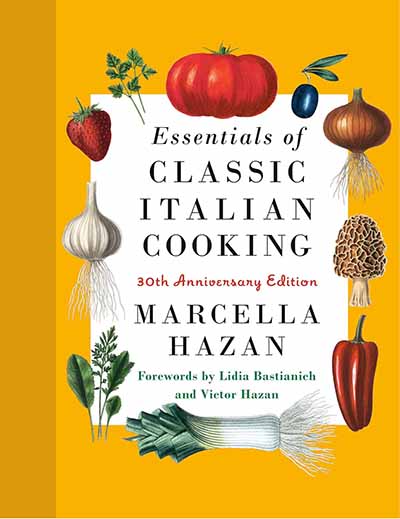
Nutrition
Nutrition information is automatically calculated, so should only be used as an approximation.
Recipe Testers’ Reviews
This is the perfect Italian Bolognese to make if you’re stuck in the house doing chores and can’t leave. A little prep work and a little stir every now and then give you a wonderful smell throughout your house and a nice, thick sauce for your pasta.
Unlike most commercial jar sauces, this sauce doesn’t have a strong tomato taste. I love that. It is pure, hearty, stick-to-your-ribs comfort food.
All you need is some warm bread, and you have a meal. The next time I make it, I’ll probably omit the oil, as I felt there was a little too much oil floating on top when it was ready to serve.
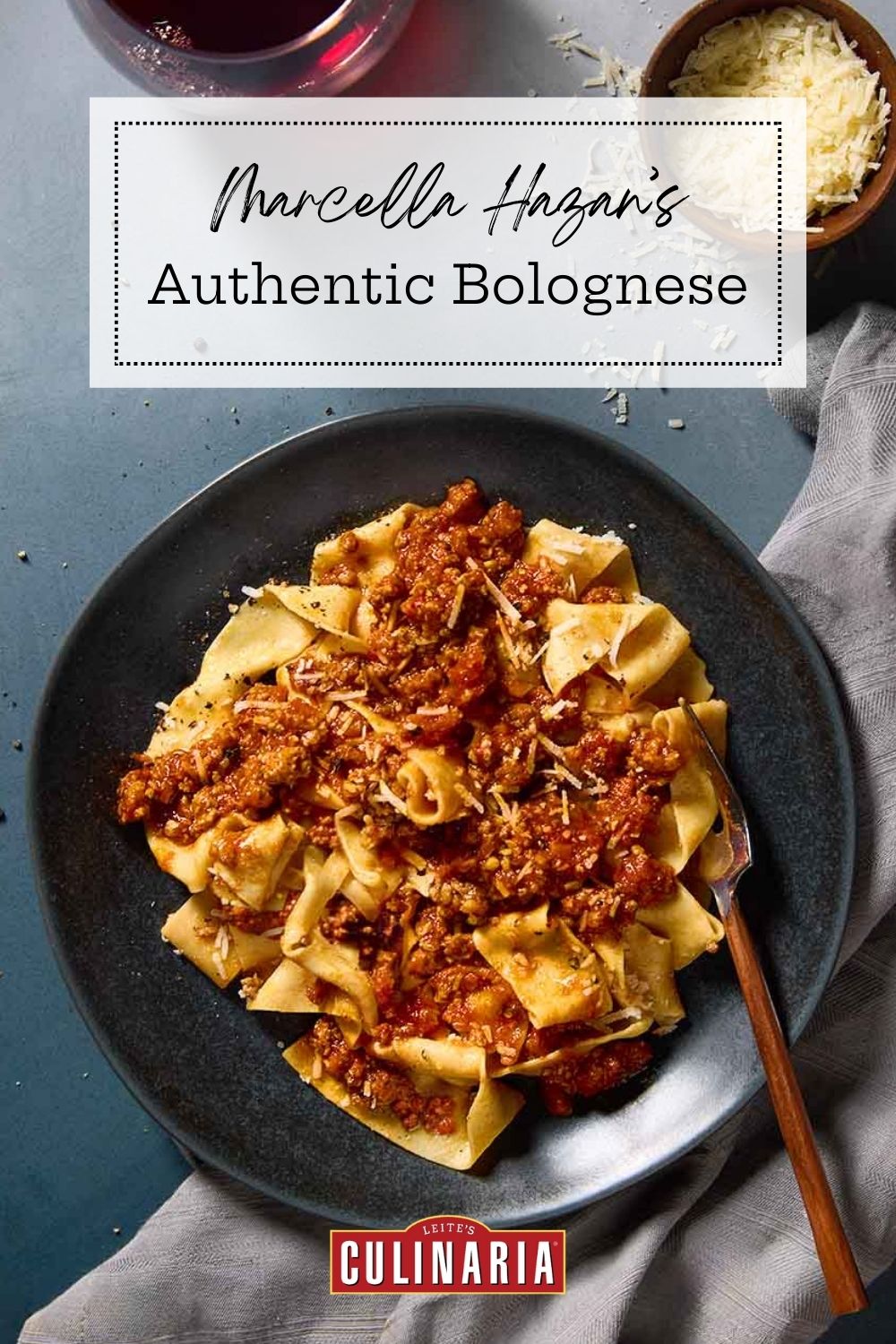
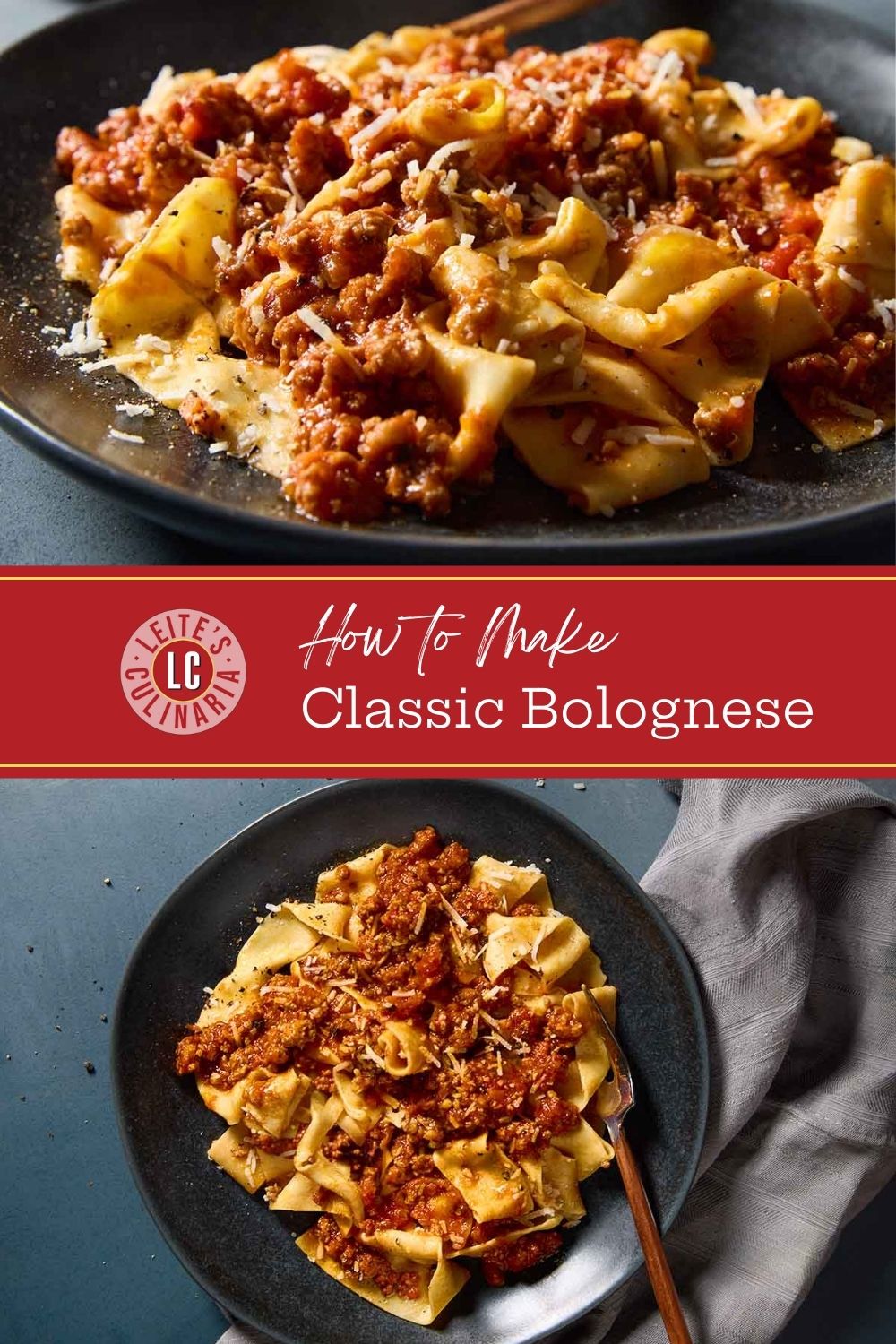
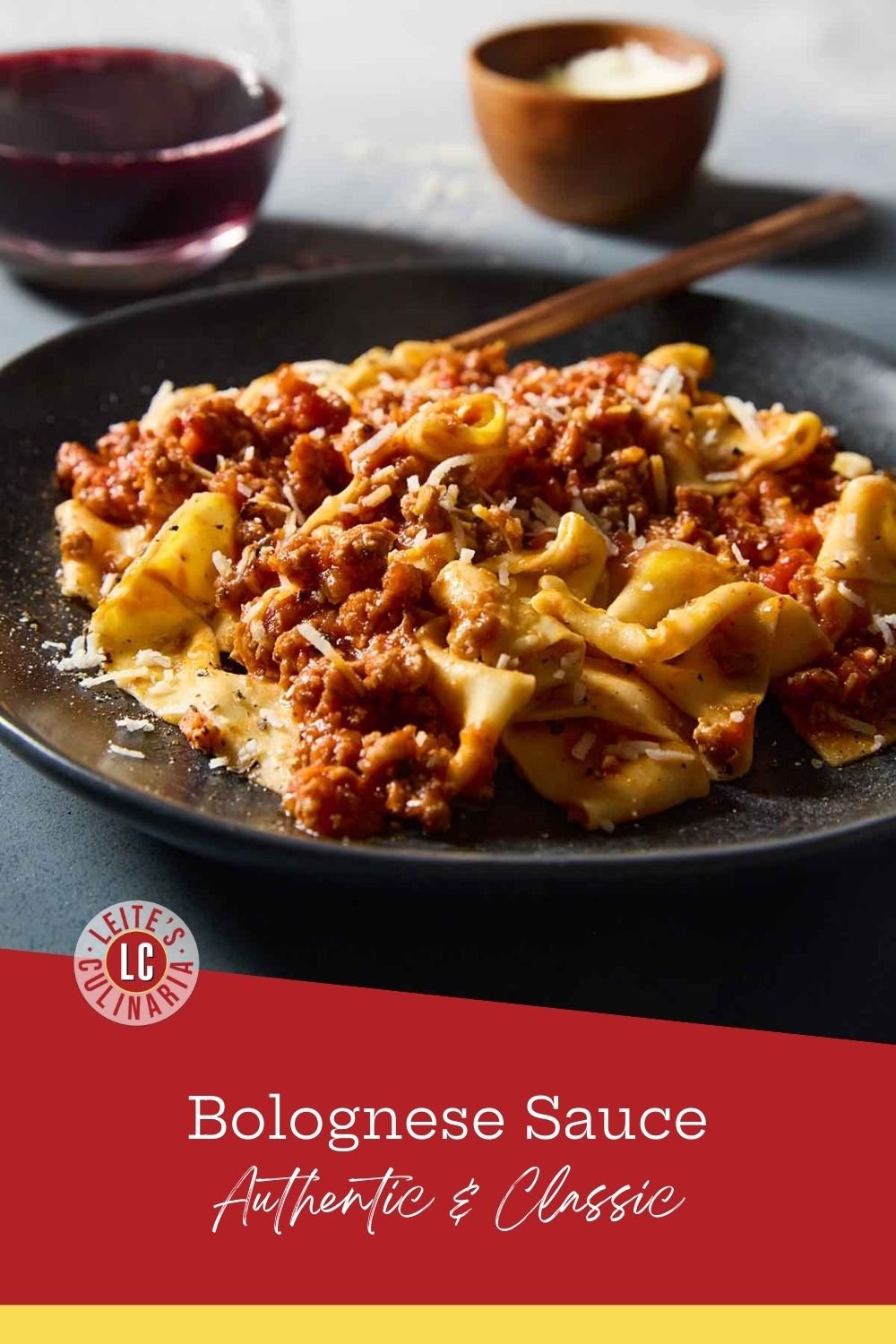
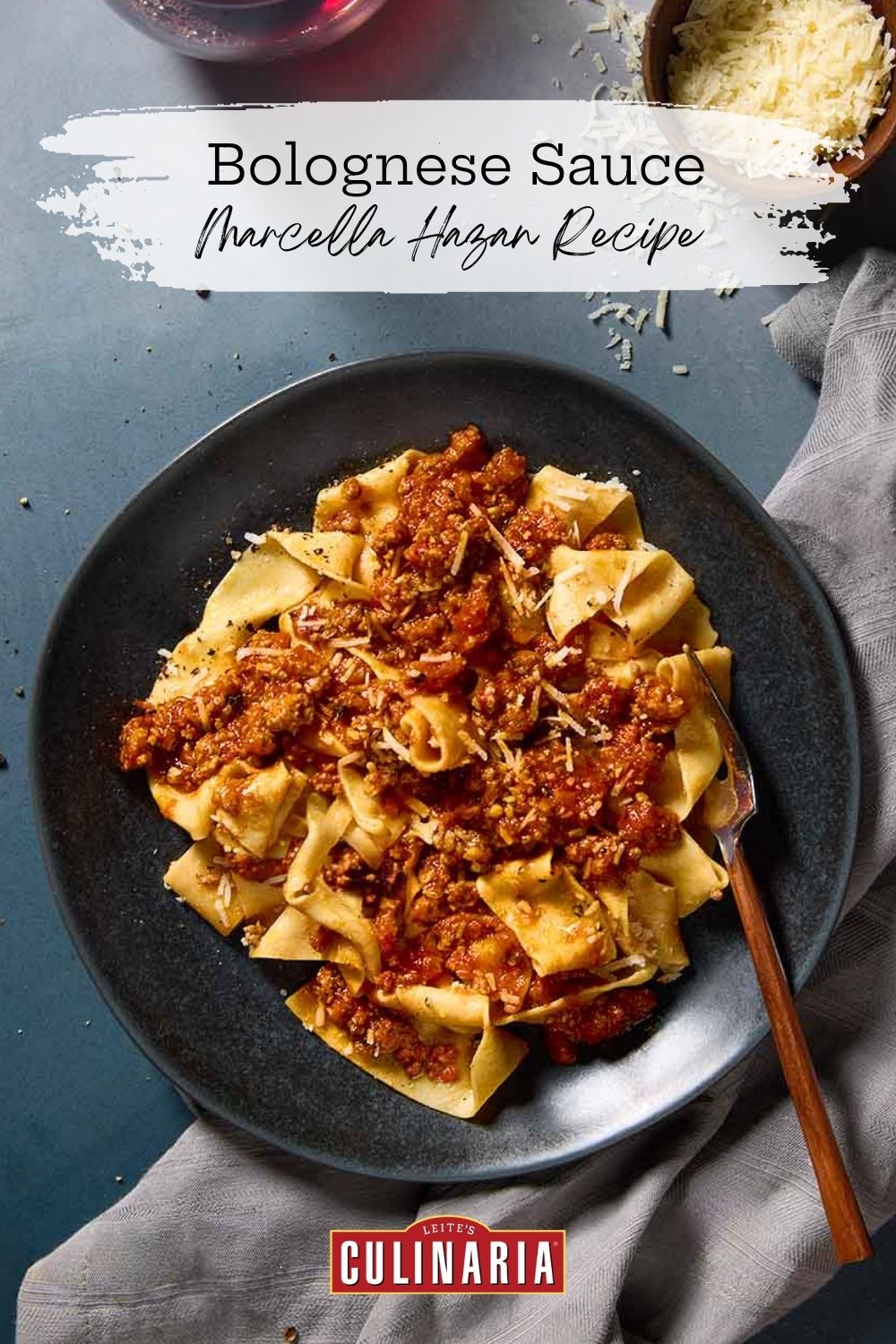
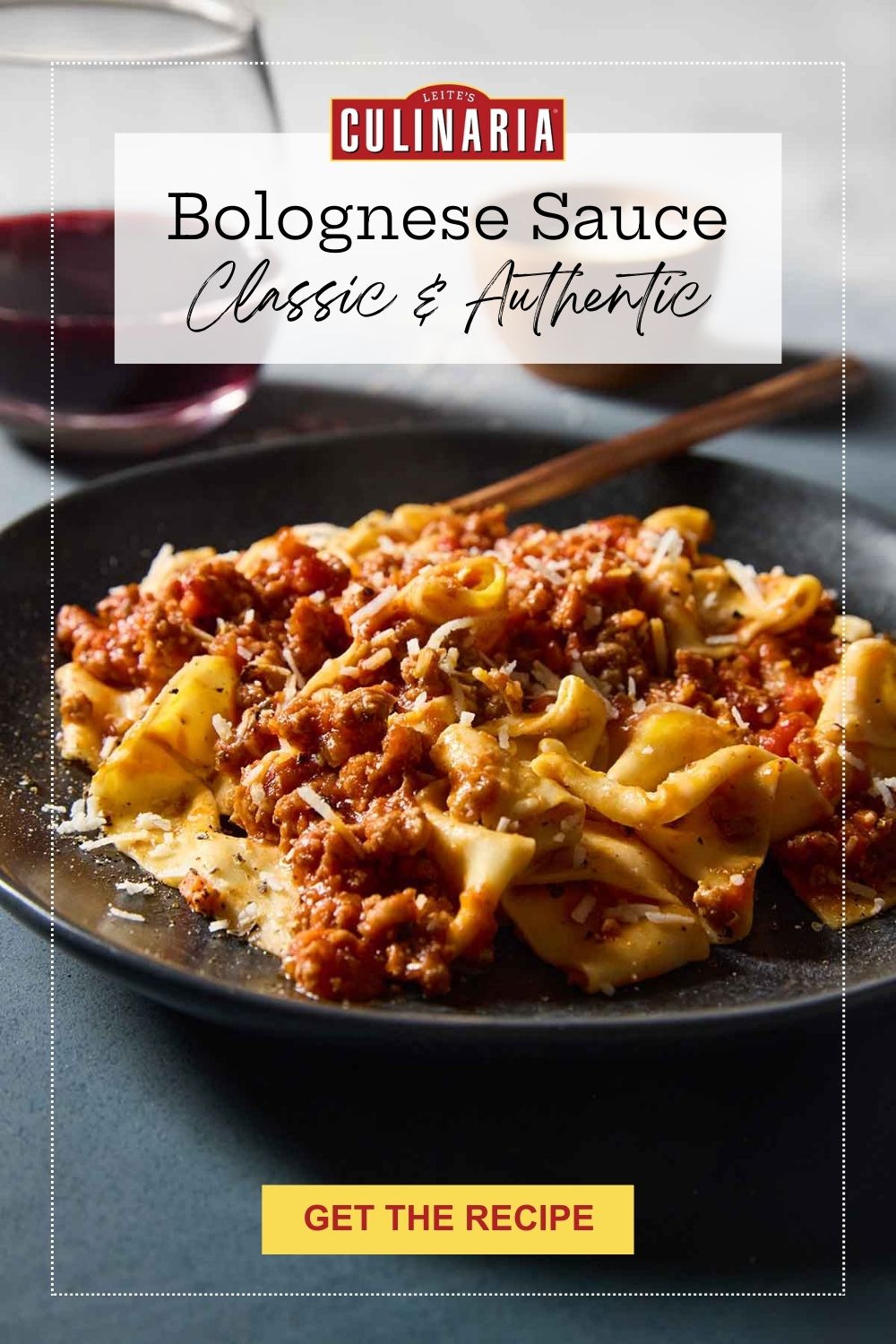










Too bad measurements not available in metric.
Peter, there are metric equivalents available for all of the recipes on the site. Simply click on the US/Metric toggle switch at the top of the ingredients list and they’ll be displayed for you.
This was delicious! It definitely takes time…you need the patience to let the milk, then wine reduce. You need to be around the house for the first few hours of prep. Once you add the tomatoes, you can cover it (I used a Dutch oven) and put it in the oven for 3 hours or more at 250 degrees and go about your day.
The taste, and depth of flavor were fantastic….so it was worth the effort. This will be my go-to meat sauce from here on out.
Christie, I could agree with you more. I LOVE your oven hack. I must try it next time.
Does this oven method really work (3 hours at 250)? I have an electric stove (which I hate) as it is very inconsistent in heating. The large burners seems impossible to get to a low setting and the small burners are too low for a decent simmer. It would be great to put this in the oven for three hours to cook.
Hello, Jay. I haven’t tried it yet using an oven method, but our reader Jennifer swears by it. And if you can cook chili in the oven, why not this? I say give it a go!
Hey David! Thank you so much for a rapid response…really appreciate it. As I was walking through my kitchen, it triggered a follow-up question regarding the bolognese recipe. Would it be possible to do the active cooking on the stove, and then when it’s time to simmer for 3 hours, to just move it into a slow cooker? As I said previously, my challenge is the heating on my electric stove is very inconsistent. So the thought is that if someone had good luck putting into an oven, wouldn’t a slow cooker accomplish similar results? Thanks.
Jay, in theory, yes. It would do the same thing. But you’re not going to get the reduction of liquid (and concentration of flavor) because the recipe calls for the pot to be uncovered for the 3 hours of cooking.
If you have the lid slightly ajar on pot in oven or slow cooker, in theory some moisture should escape and get you the reduction. Particularly in the oven I would want to make sure it wasn’t drying out too quickly.
But here’s an out-of-the-box idea that might be more generally useful: why not buy an induction burner? Assuming you have a suitable pot (Dutch oven should be), you can get a nice low simmer, or boil water quickly for the pasta once sauce is done, and it doesn’t heat up your kitchen nearly as much.
Bill, thanks for your comment. I’m not a big slow-cooker cook, so this was helpful. And spot on regarding the induction burner. When we lost the use of our stove for six months while our building was repairing the gas lines, we made everything on an induction burner. And I use it in the step photos that we’re adding to recipes.
Hey Bill – thanks so much for the two great suggestions. I will definitely leverage this weekend when I tackle the recipe for the first time. I was googling slow cooker bolognese recipes this afternoon and noticed the cook time is much longer (~6 hours), so I’m guessing that’s to accommodate the slower reduction. Appreciate your suggestions.
There was so much liquid when I added the milk to the fat from the meat, that it never simmered off. The meat was just swimming in a pool of liquid.
Then adding the wine on top, I had a soup.
Jeff, did you cook the meat all the way? The meat needs to cook until it just lost its raw red color. If fully cook it, it can’t absorb the milk.